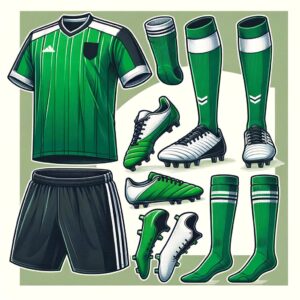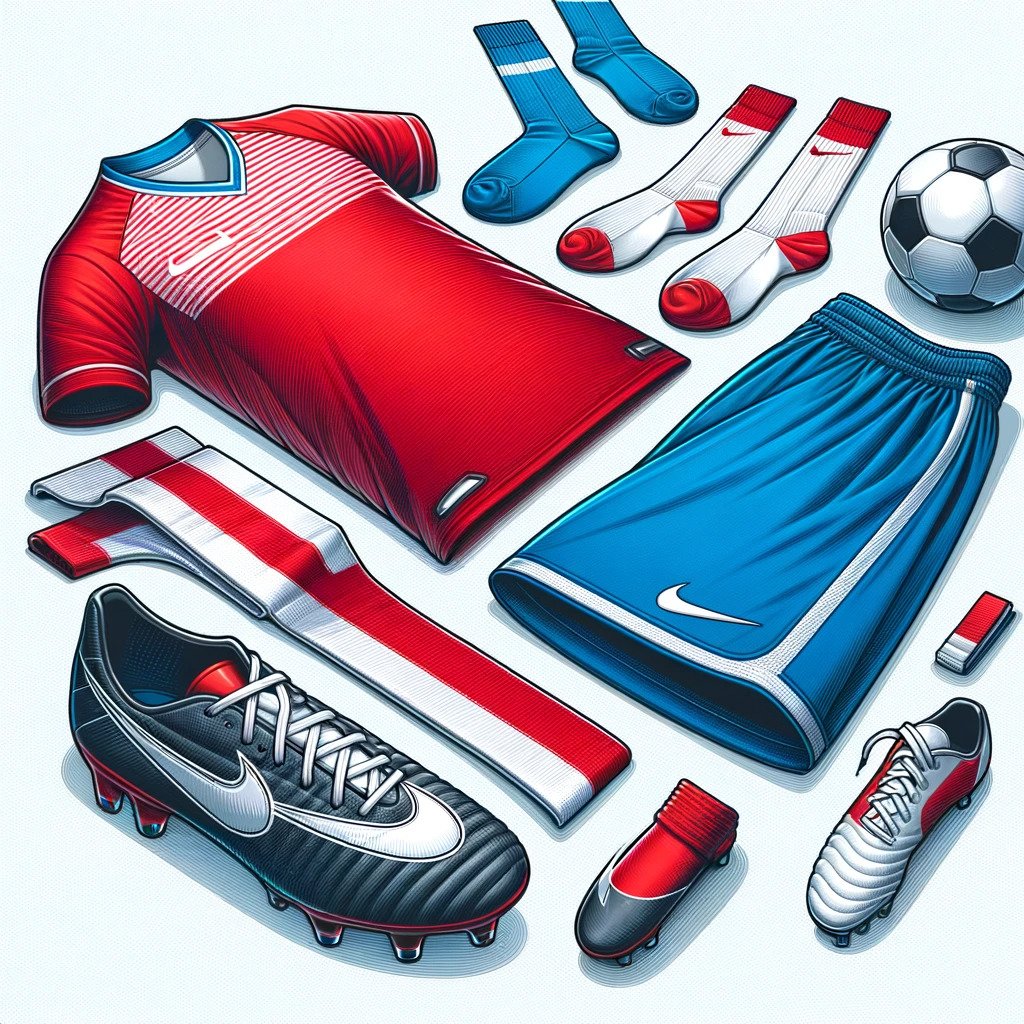In the world of soccer, the kit holds a significance that extends beyond mere uniform. It’s a symbol of unity and identity, a canvas where the team’s ethos is expressed through colors, logo, and design. Growing up playing soccer, I remember the excitement of donning the shirt, shorts, and socks; they were not just pieces of fabric, but a transformation into a player, a part of something bigger.
Each kit is meticulously designed to reflect the team’s brand and heritage. Often, players have two different colored kits – the home and away games versions. These colors are not just visually distinct but also carry a deep connection with the team’s history and its supporters. The goalkeeper’s kit, usually in a starkly different color, serves a functional purpose too, helping to distinguish them from other players on the field.
In some international countries, the term kit encompasses more than just the basic uniform. It includes all the essential equipment a player needs: from cleats to shin guards, each item is a crucial part of the gear. This broader understanding of a kit reflects the comprehensive preparation a player undergoes, highlighting the importance of each item in their arsenal.
What Is a Kit in Soccer?

In soccer, a ‘kit’ is more than just a uniform; it’s an emblem of pride and belonging. Every component, from the shirt to the shorts and socks, plays a critical role. As a former youth coach, I’ve seen how a kit transforms players from individuals into a cohesive unit.
The Essentials: Shirt, Shorts, and Socks
Per the International Football Association Board’s Rule 4, every player’s kit must include a shirt or jersey with sleeves, shorts, and socks. The goalkeeper often wears pants to distinguish themselves from other players and the referee. Remember, comfortable gear can make all the difference on the field.
Beyond Basics: Shin Guards and Footwear
Shin guards are crucial. They prevent injuries during match play and should be worn in training too, though not all coaches enforce this. The choice of footwear should consider local surface conditions, especially for youth soccer players. Both outdoor and indoor cleats are essential, adapting to different playing fields.
The Nos: Jewelry and Non-Essential Items
Items like earrings, rubber bands, leather bands, or any jewelry are not permitted while playing soccer. Safety first – these items can cause harm if they break or fall off during a game.
Additional Gear: Gloves, Hats, and Glasses
In colder regions like the northeast in November, wearing gloves is almost a requirement. Goalkeepers often use specialized gloves. Hats and glasses are allowed, particularly for goalies to shield against sunlight. However, ensure they’re secure and won’t cause injury.
Protective Headgear and Body Armor
Headgear like headbands and soft shell helmets, as well as knee and arm protectors made of lightweight padded material, are all permitted. These extra pieces offer added protection and peace of mind on the pitch.
Components of a Soccer Kit
The soccer kit is more than just apparel; it’s a symbol of a team’s identity and culture. Every component plays a role in the game, from the shirt or jersey to the shorts, socks, and cleats or boots. Each player wears these elements, not just for comfort but as part of a larger heritage.
The Shirt and Jersey
The shirt or jersey is perhaps the most recognizable part of the kit. Featuring the team’s colors, crest, and sponsor logos, it’s a canvas that tells a story. These are crafted from lightweight, breathable materials, designed to keep players cool and ensure maximum movement.
Shorts and Socks: Designed for Performance
Shorts in a soccer kit, usually matching the shirt, are essential for flexibility and comfort. Similarly, the knee-length socks are not just for style; they provide support and cover the shin guards, vital for performance on the field.
Footwear
Soccer cleats or boots are specially designed for traction and support. Choosing the right pair can significantly influence a player’s movement and efficacy during play.
Goalkeeper’s Specialized Gear
The goalkeeper, the unique sentinel of the team, has their own specialized kit. This includes gloves, padded shorts, and a jersey with padded elbows, all crucial for their role in the game.
The Importance of Personalization
A soccer kit becomes a personal item when it features the player’s name and number. It connects fans with their favorite players and generates revenue through the sale of personalized jerseys.
The Fit: Tailored for Soccer
Unlike sports kits in American football or basketball, which are looser-fitting and made of thicker, heavier materials, soccer kits are form-fitting. This tight fit to the body helps in reducing drag and hinders the possibility of opponents grabbing the fabric, a potential foul.
The Design of a soccer kit
The design of a soccer kit often reflects the team’s history. It includes primary colors, often based on the team’s logo or flag, and sometimes secondary colors for accents. The crest or intricate emblem is prominently displayed, along with patterns like stripes, hoops, or checkerboards.
Typography and Special Features
The team name or motto might be displayed in a distinctive font or typography. Special features like mesh panels for ventilation or moisture-wicking materials enhance the cohesive look of the kit.
Ultimately, the design of a soccer kit plays a significant role in shaping a team’s identity and creating a sense of unity among players and fans.
Importance of a Soccer Kit

Soccer kits play a pivotal role far beyond mere clothing. They are essential for identification, allowing fans, referees, and players on the field to distinguish between different teams. The distinctive colors and patterns of these kits make it easy to recognize a player and their team.
Uniting Players and Fans
Beyond identification, these kits foster a sense of togetherness and team spirit. As a former player, I know the feeling of unity and pride when wearing a uniform. It helps players feel like an integral part of the team, strengthening the bond connected with teammates and coaches.
A Symbol of Professionalism
In higher leagues, soccer kits embody professionalism and give teams a professional look. This aspect is crucial, especially for teams playing at a high level. The design and quality of the kit reflect the team’s standards and ethos.
The Business Side: Sponsorships and Merchandise
Sponsorships are integral to soccer kits. The logos of sponsors on the kit not only generate revenue but are also lucrative in supporting the team’s ability to invest in training facilities, equipment, and other resources. Furthermore, fan merchandise has become increasingly popular, with fans eager to wear the colors of their favorite team. This also boosts merchandise sales and helps in fan support.
A Cultural Phenomenon
The soccer kit has transcended the sport, becoming a cultural icon in its own right. It connects the past with the present, embodying the history and aspirations of both the team and its supporters.
What Does a Soccer Uniform Have on It?
A soccer uniform, or jersey, is much more than just an item of clothing for the players; it’s a tapestry of identity. Each jersey typically features the player’s last name and number, alongside the team’s logo.
Moreover, it often carries the emblem of a sponsor and occasionally a meaningful slogan, representing not just the team, but also the community and ideals it stands for.
Why Goalkeeper has a Different Colored Jersey?
In soccer, the goalkeeper wears a different colored jersey compared to the rest of the team. This distinction is crucial for several reasons. Primarily, it helps to distinguish the goalkeeper from other players on the field. In the thick of the game, this visual cue allows teammates and referees to quickly identify the player with the unique privileges and responsibilities of this position. The goalkeeper’s role to prevent scoring is pivotal, and being easily recognizable supports this function.
Moreover, the goalkeeper’s jersey typically sports a bright color, enhancing visibility. Especially in situations like the penalty area, where the goalkeeper might be partially obscured by other players, this vibrant hue ensures they remain conspicuous.
This aspect of the soccer kit is not just a matter of style but adheres to soccer rules and regulations, ensuring the game is played fair and safe. It’s a unique identity within the team, signifying the goalkeeper’s distinct role.Top of Form
Do Soccer Kits Change Every Season?
Soccer kits often change each season, but this is largely dependent on the team’s preference and their contract with the kit manufacturer. While some teams opt to update their kits annually or even mid-season, others may stick with the same design for multiple seasons.
The decision to alter the kit’s appearance is influenced by various factors, including branding and sponsorship agreements. A new sponsor or shift in branding elements often necessitates a change in the kit’s color or design to incorporate these new identities.
Furthermore, kit manufacturers, under contracts spanning several years, frequently introduce new kits each season. These could be regular updates or special edition kits designed to commemorate a special event or launch a third kit. The frequency of these changes reflects a blend of marketing strategies and the evolving identity of the teams.
Prohibition on Removing of Soccer Jerseys
In the world of soccer, it is prohibited for soccer players to remove their jerseys during a match. This rule is in place to maintain sportsmanship and decorum on the field. Removing a jersey is seen as unsportsmanlike behavior, and doing so can lead to disciplinary actions by the referee, including a yellow card or even a red card. The act is often interpreted as excessive celebration, an attempt to taunt the opposing team or fans, or as a tactic to waste time and delay the game.
Additionally, there are safety concerns associated with removing a jersey. Players become more susceptible to injury by exposing their skin to other players or to environmental elements. Therefore, soccer’s strict rules about player behavior on the field include this as a violation, emphasizing the importance of respect and professionalism in the sport.Top of Form
What If the Law Is Infringed?
When a player fails to abide by the rules regarding soccer kits, specific procedures are set in motion. The referee may instruct the player to leave the ground temporarily for equipment rectification. This could involve resolving issues with missing equipment or ensuring compliance with the regulations.
After reporting back to the referee and having their equipment thoroughly reviewed and approved, the player is then allowed to return to the match.
However, their re-entry is contingent on the ball being out of play, ensuring the flow of the game is not disrupted. This protocol ensures fairness and safety in the game, allowing players a chance to enter the field in compliance with the sport’s standards.
What do kit numbers mean in soccer?
In soccer, kit numbers are not just random selections; they play a significant role in the game. Soccer numbers on jerseys are primarily used to identify the players and their positions on the field. Each number has a traditional association with specific positions in football, making it easier for fans, coaches, and commentators to follow the action. The shirt numbers often mean more than just identification; they can signify a player’s role within the team or even hold a sentimental value for the player.
let’s break down some of the traditional associations of jersey numbers in soccer and their corresponding positions:
- Number 1: Typically reserved for the goalkeeper. This number is almost universally associated with the player who guards the goal.
- Numbers 2 – 4: Often assigned to defenders. Number 2 is usually for the right-back, while numbers 3 and 4 are for centre-backs or left-backs.
- Number 5: Also a defender’s number, commonly a centre-back. This player is often pivotal in defense.
- Number 6: This is usually a defensive midfielder’s number. They play just ahead of the defense and are key in breaking up opposition attacks.
- Number 7: Traditionally a number for a right winger or a right midfielder, known for their speed and ability to cross the ball.
- Number 8: Often a central midfielder, balancing defensive responsibilities with the need to push forward and support attacks.
- Number 9: This is the classic striker’s number. Number 9s are known for their goal-scoring abilities.
- Number 10: Often worn by the playmaker or attacking midfielder. This number is associated with creative players who can change the game with their vision and skill.
- Number 11: Typically a left winger or left midfielder, mirroring the role of the number 7 on the opposite flank.
Here is the breakdown of soccer jersey numbers and their traditional positions presented in a tabular form:
| Jersey Number | Traditional Position |
| 1 | Goalkeeper |
| 2 | Right-Back |
| 3 | Centre-Back / Left-Back |
| 4 | Centre-Back / Left-Back |
| 5 | Centre-Back |
| 6 | Defensive Midfielder |
| 7 | Right Winger / Right Midfielder |
| 8 | Central Midfielder |
| 9 | Striker |
| 10 | Playmaker / Attacking Midfielder |
| 11 | Left Winger / Left Midfielder |
A breakdown of jersey numbers reveals a fascinating aspect of football culture, where certain numbers are revered and associated with specific playing styles or legendary players who wore them.
Conclusion
Understanding the nuances of a soccer kit, from the significance of jersey numbers to the strict regulations governing their use, offers a deeper appreciation of the sport’s rich culture and history. Each element of the kit, be it the colors, the badge, or the number, carries a story and a tradition that resonates with players and fans alike. These conventions not only aid in the practical aspects of the game, such as player identification and team unity but also contribute to the unique identity and heritage of each soccer team.
Frequently Asked Questions
What is a third kit in soccer?
A third kit in soccer, also known as an alternate kit, is an additional uniform used by teams. It’s designed to avoid color clashes with the opposing team’s home and away kits during matches. The third kit often features unique designs and color schemes distinct from the primary home and away jerseys.
Why are they called soccer kits?
The term “soccer kit” refers to the standard equipment and attire worn by players. “Kit” in this context is a British term that traditionally means a set of articles or equipment needed for a specific purpose, which in this case, is playing soccer. It includes items like jerseys, shorts, socks, and footwear.
Why are there 3 kits in soccer?
There are 3 kits in soccer – home, away, and third kits – to ensure there is no color conflict between teams during a match. While the home and away kits are standard, the third kit provides an additional option to avoid color clashes, especially in tournaments or leagues where multiple teams might have similar primary colors.
What do you wear under a football kit?
Under a football (soccer) kit, players typically wear base layers or undergarments designed for comfort and performance. These can include compression shorts, sports undershirts, or specific protective gear like padded undershorts. These base layers help in muscle support, temperature regulation, and providing additional protection.
How do teams decide which kit to wear?
Teams decide which kit to wear based on several factors, including home or away game status, opponent’s kit colors, and league or tournament rules. The home team usually wears its primary kit, while the away team uses its secondary kit to avoid color conflicts. If both primary and secondary kits clash, the third kit may be used. Decisions are often coordinated with the league officials and the opposing team to ensure clarity and compliance with the rules.

